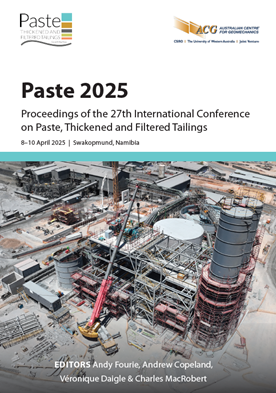Risk-informed instrumentation of tailings storage facilities

|
Authors: Herza, J; Singh, R |
DOI https://doi.org/10.36487/ACG_repo/2555_49
Cite As:
Herza, J & Singh, R 2025, 'Risk-informed instrumentation of tailings storage facilities', in AB Fourie, A Copeland, V Daigle & C MacRobert (eds), Paste 2025: Proceedings of the 27th International Conference on Paste, Thickened and Filtered Tailings, Australian Centre for Geomechanics, Perth, pp. 683-690, https://doi.org/10.36487/ACG_repo/2555_49
Abstract:
Surveillance through instrumentation and monitoring is crucial for evaluating performance and ensuring the safety of tailings dams. This importance has been well recognised by technical groups and peak industry bodies, which have released numerous publications emphasising the necessity and benefits of, and the developing techniques for, tailings dams monitoring. The attention to instrumentation has further intensified with the introduction of technologies such as InSAR, marketed specifically for the tailings industry, and the monitoring requirements outlined by the Global Industry Standard on Tailings Management (GISTM). However, the collapse of the Brumadinho dam, equipped with over 100 piezometers and several inclinometers, demonstrated that an extensive surveillance program with large quantities of instruments alone cannot prevent dam failures. Moreover, there is no one-size-fits-all solution for surveillance programs. A standardised approach to instrumentation and monitoring is neither feasible nor beneficial as each facility has unique characteristics and risks. For safety monitoring to be truly effective it must be tailored to the specific failure modes and risk controls of the facility, ensuring that deviations from expected performance are detected early enough to provide actionable warnings. This paper presents a robust, risk-informed framework for developing effective safety surveillance programs that allow tailings storage facilities owners to detect the deteriorating performance of tailings facilities and potential failure conditions, and which align with the tailings dam management framework adopted for the forthcoming revision of the Australian National Committee on Large Dams Guidelines on Tailings Dams.
Keywords: instrumentation, monitoring, risk controls, surveillance
References:
ANCOLD 1983, Guidelines for Dam Instrumentation and Monitoring Systems, Australian National Committee on Large Dams, Hobart.
ANCOLD 2012, Guidelines on Tailings Dams-Planning, Design, Construction, Operation and Closure, Australian National Committee on Large Dams, Hobart.
ANCOLD 2019, Guidelines on Tailings Dams-Planning, Design, Construction, Operation and Closure – Revision 1, Australian National Committee on Large Dams, Hobart.
Herza, J, Coffey, J & Singh, R 2023, ‘The tailings safety case – an example’, Tailings and Mine Waste Conference 2023, Geotechncial Centre, University of Alberta, Vancouver.
ICOLD 1969, Bulletin 21 General Considerations Applicable to Instrumentation for Earth and Rockfill Dams, International Commission on Large Dams, Rotterdam, Boston.
ICOLD 1984, Deterioration of Dams and Reservoirs – Examples and Their Analyses, International Commission on Large Dams, Imprimerie de Montligeon, Paris.
ICOLD 1988, Bulletin 60 Dam Monitoring – General Considerations, International Commission on Large Dams, Imprimerie de Montligeon, Paris.
ICOLD 1996, Bulletin 104 Monitoring of Tailings Dams, International Commission on Large Dams, Imprimerie de Montligeon, Paris.
ICOLD 2018, Bulletin 158 Dam Surveillance Guide, International Commission on Large Dams, Taylor & Francis, Paris.
ICOLD 2022, Bulletin 194 Tailings Dam Safety, International Commission on Large Dams, Taylor & Francis, Paris.
International Council on Mining and Metals 2021, Tailings Management – Good Practice Guide, London.
Morgenstern, N, Vick, S & Van Zyl, D 2015, Report on Mount Polley Tailings Storage Facility Breach, Government of British Columbia, Victoria.
Morgenstern, N, Vick, S, Viotti, C & Watts, B 2016, Fundão Tailings Dam Review Panel – Report on the Immediate Causes of the Failure of the Fundão Dam, .
Robertson, P, de Melo, L, Williams, D & Wilson, G 2019, Report of the Expert Panel on the Technical Causes of the Failure of Feijão Dam I,
© Copyright 2025, Australian Centre for Geomechanics (ACG), The University of Western Australia. All rights reserved.
View copyright/legal information
Please direct any queries or error reports to repository-acg@uwa.edu.au
View copyright/legal information
Please direct any queries or error reports to repository-acg@uwa.edu.au
